Are you ready to hone your Pitmaster skills and make the best smoked brisket you’ve ever had? Look no further than this ultimate guide on how to smoke a brisket.
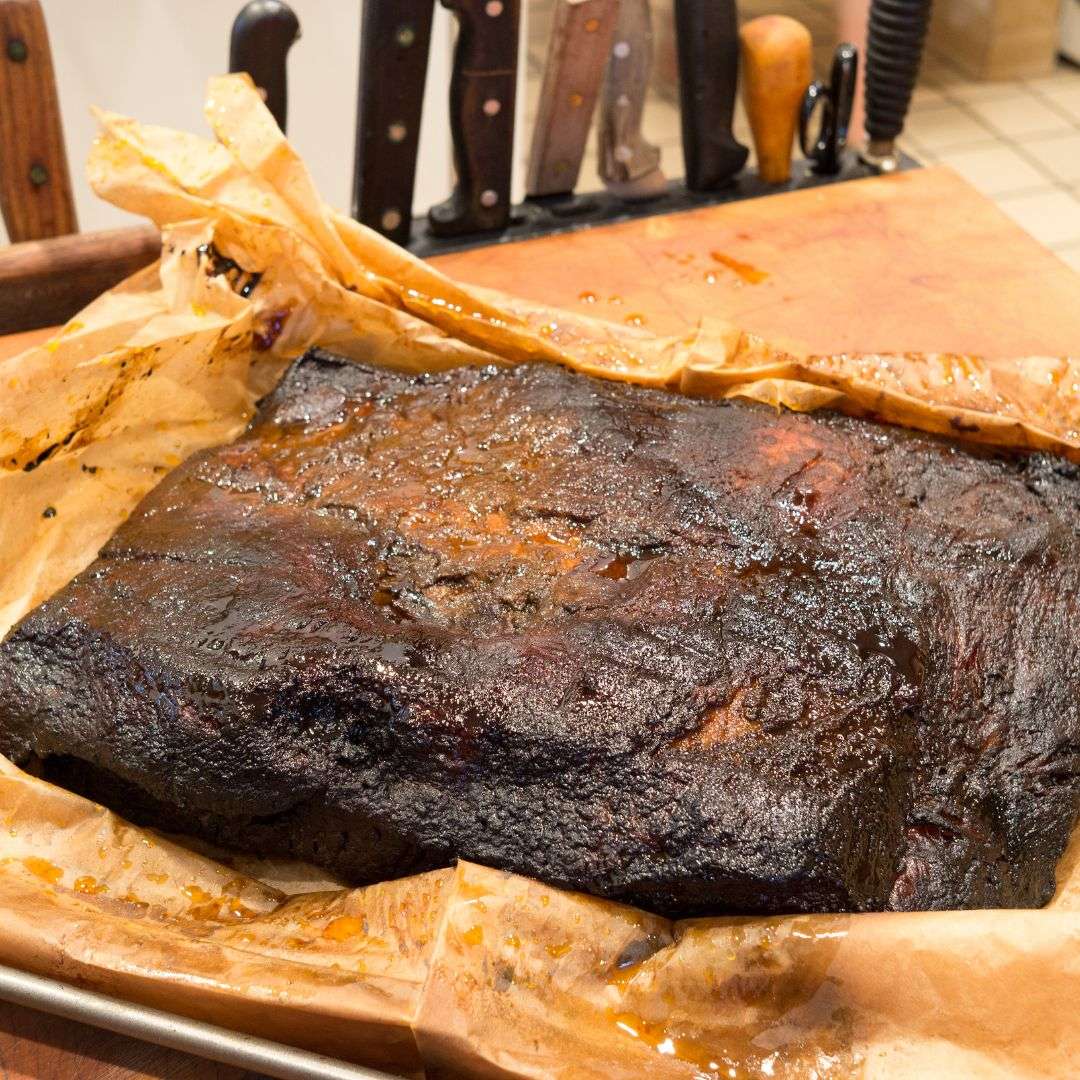
This large, primal cut is considered the king of BBQ meats, and with the right tools and knowledge, even new backyard chefs can smoke it to perfection. We’ll guide you through everything you need to know, from choosing the right brisket to trimming and seasoning and smoking and carving. Take your Pitmaster skills to the next level using our comprehensive guide on how to smoke a brisket.
Smoked Brisket Basics
Brisket is considered the most challenging barbecue. This huge, tough cut of meat takes hours to smoke to perfection and yields a tender, flavorful slice of meat with bold barbecue flavors.
This method for smoked brisket is straightforward, and while it will take some time, it is easy as long as you research your smoker’s capabilities and remain patient. Remember, the key to a perfectly smoked brisket is patience. So, take a deep breath, trust the process, and enjoy the journey of smoking your brisket to perfection.
The size and fat content of the brisket are crucial for a successful smoke. For this method, you’ll need a large, completely untrimmed chunk of beef, preferably over 12 pounds and with a significant amount of fat. If you can’t find this specific cut, don’t hesitate to ask your butcher or find another one who can provide it.
What You Will Need
- One large, untrimmed beef brisket (see the Brisket Buying Guide)
- A large smoker
- A lot of fuel for your smoker (depending on the type of smoker you have)
- A way of lighting more charcoal outside the smoker (if you are using a charcoal smoker)
- Hardwood chunks
- A good brisket rub
- Pink butcher paper
- A meat injection needle
- A reliable meat thermometer
- A good brisket mop or spritz
- A good brisket barbecue sauce
- A filet knife
- A very large cutting board
- This process can take up to 24 hours from start to finish, depending on the path you take, so plan accordingly.
Smoked Brisket – Knowing your Beef Brisket
A large, untrimmed brisket will weigh between 10 and 20 pounds, depending on its preparation and place of purchase. A smoked brisket will render half its weight during this process, meaning if you buy a 12-pound brisket, you will get about 6 pounds of meat once it is cooked. This size reduction is caused by two things: trimming the brisket and shrinkage during cooking.
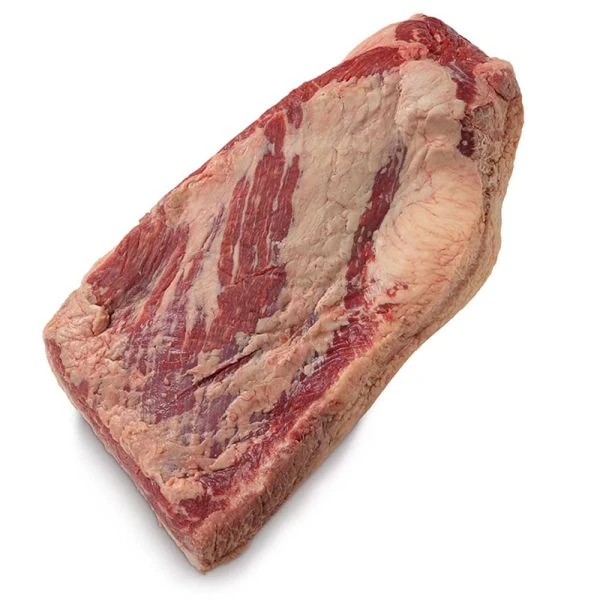
Photo: Snake River Farms
The Whole Packer Brisket
Whole packer briskets can range anywhere from 12-18 pounds. It is a large slab of meat covered by a thick layer of hard fat on one side, with another layer of fat that runs through the middle on the thicker end of the brisket. The large piece of meat that runs along the bottom is called the flat. The meat towards the top side (fat side) is called the point (typically used to make burnt ends). These two pieces of meat run in different directions and can present a challenge when it comes to carving. However, this guide will help you carve your smoked brisket like a champion!
Trimming a Brisket
For new BBQ cooks, trimming a whole packer brisket can be intimidating. But never fear; we’ll walk you through how to do it.
To make the brisket smoker ready, it must first be cleaned and pared down to a more manageable size. Now, that doesn’t mean cutting it up or carving off all the fat, but it is easier to work with when properly prepared. The only time you’ll need to carve off most of the fat is if you’re attempting a quick brisket, which is cooked in 5 hours and will not have enough time to render properly. However, we are guiding you through a long, low and slow method, so keeping some of the fat on is advised.
For this step, you’ll need a filet knife and sharp kitchen shears.
Trimming Step-by-Step
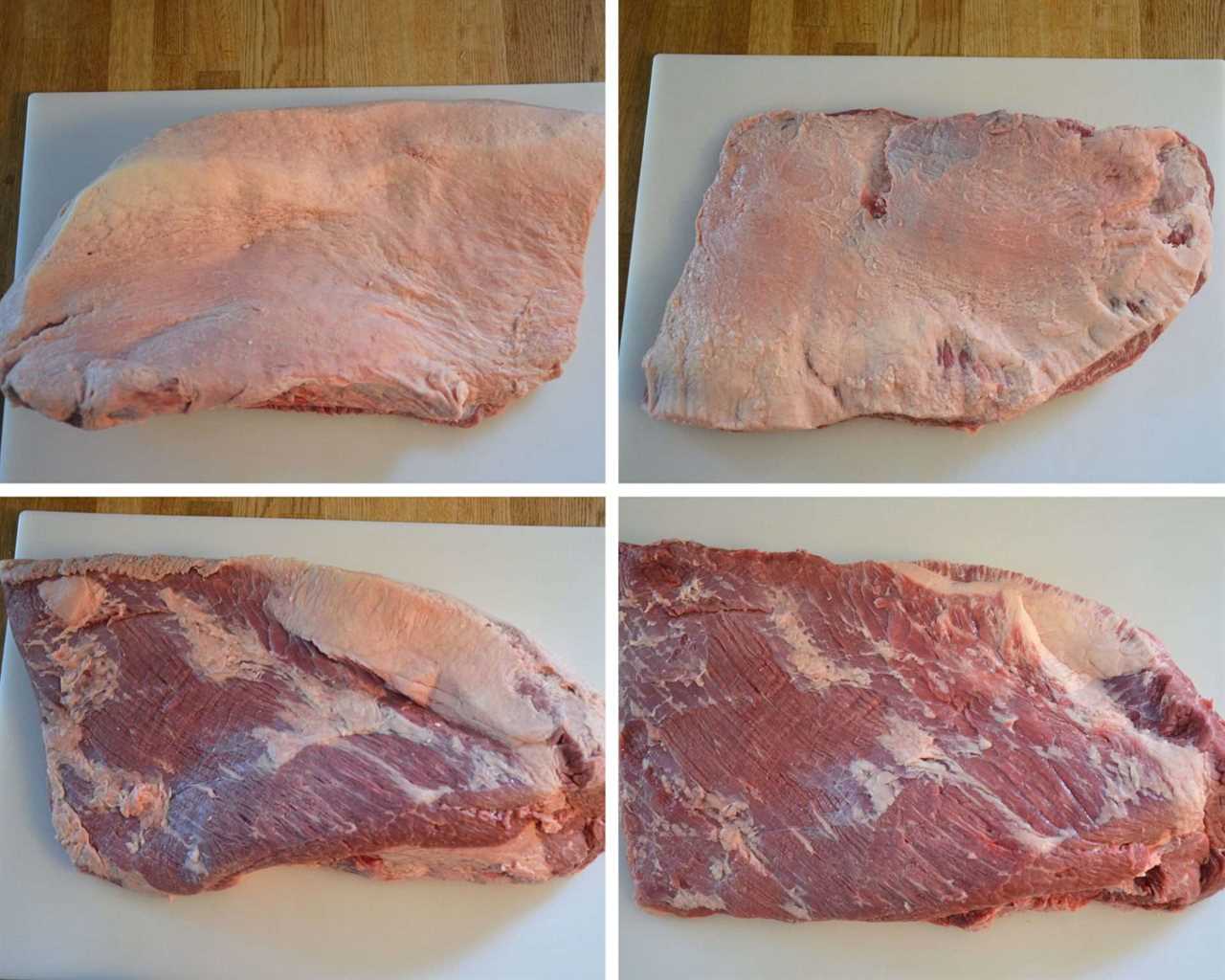
- Trimming stragglers: start by going over the beef brisket and snipping off any loose pieces of meat or fat with kitchen shears. A thin strip of meat hanging off the side is going to dry up and overcook, so there is no point in keeping it.
- Once you have the loose pieces off, flip the brisket over on the meatier side. Here, you may find pieces of the membrane similar to that on a rack of BBQ Ribs. While you don’t need to remove all of it, it can create a flavor barrier by preventing smoke and seasonings from penetrating the meat.
- Trimming the fat: a whole beef brisket contains a large amount of fat, too much in some places. If you know anything about smoking brisket, you know that the fat keeps the meat moist during cooking and adds flavor as it slowly breaks down. Keep in mind that the most important fat in your brisket is not the hard fat cap (the fatty side of the brisket) but the fat inside distributed throughout the meat. These small ribbons add an extra dimension of flavor and moisture.
- Use your filet knife and slowly strip the fat away, strip by strip. Don’t cut down to the meat. Only carve off the excess soap-like fat. By doing this, you can reduce the weight of the brisket by a pound or two and thereby reduce the overall cooking time.
- Finally, square the sides so that the brisket has a uniform shape.
- Save the fat to make beef tallow.
Brisket Injection Marinade
It takes a long time to smoke a beef brisket, so you and your brisket need a good night’s rest before getting started. Because brisket is so thick, it is a good idea to infuse flavor and moisture deep into the meat with an injection marinade. There are several commercial brisket injection marinades available on the market, or you can make this Competition Brisket Injection instead.
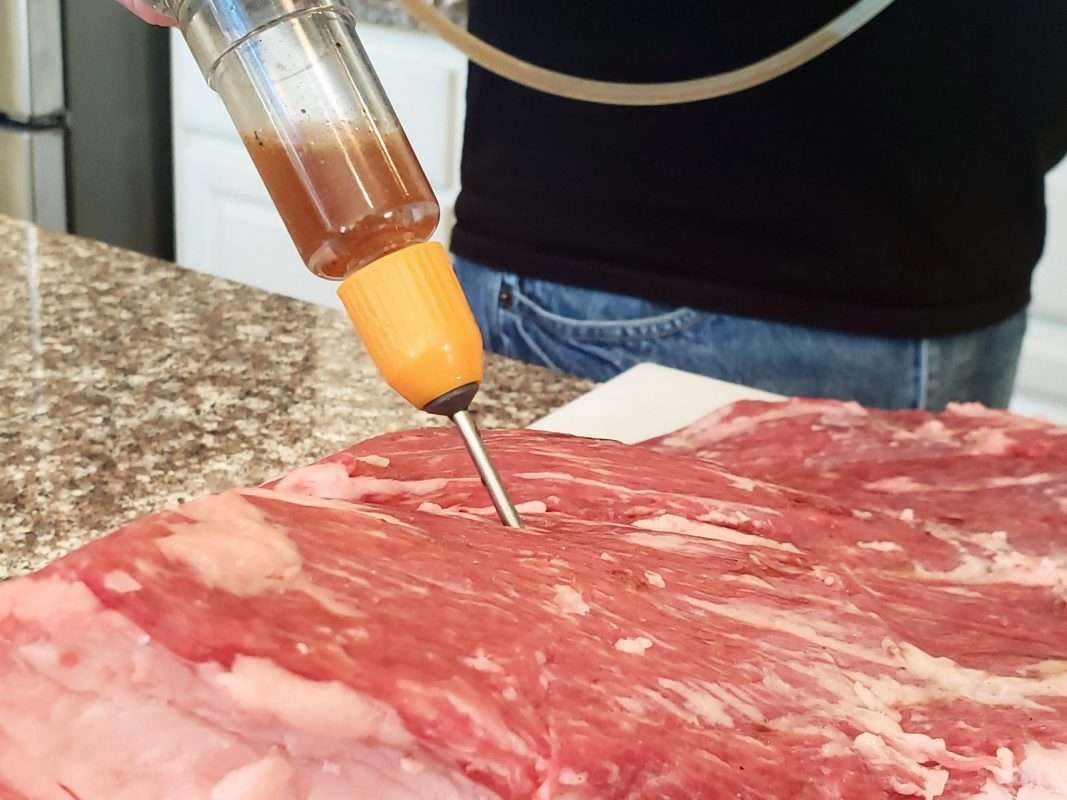
derrickriches.com
- To use an injection marinade, load the liquid into your meat injector, insert it into the meaty portions of the brisket, and slowly release a small amount of the marinade. Injecting too much liquid will cause spillage. Inject multiple spots for even distribution. Let the brisket stand for 15 minutes to allow the marinade time to settle before handling.
- Next, carefully secure the brisket in plastic wrap and store it in the refrigerator overnight.
- Save the remaining injection marinade to use as a spritz later on.
Applying the Rub
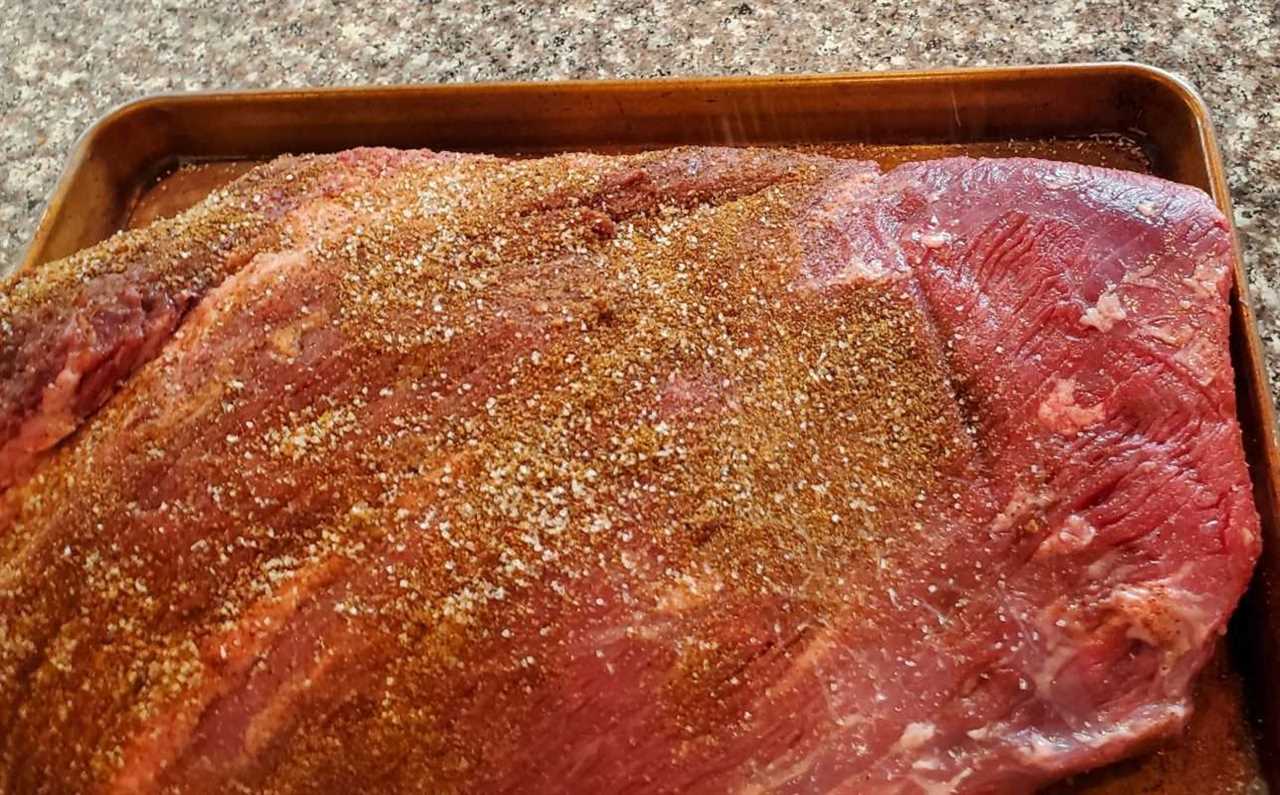
- Remove the brisket from the refrigerator and unwrap it.
- Mop away any excess spillage from the injection marinade. Transfer it to a cutting board.
- Carefully apply a light coating of Worcestershire sauce or yellow mustard to the surface of the brisket.
- Next, season the brisket evenly with a good rub like a Texas style SPG (salt, black pepper, and garlic powder). Let the brisket stand at room temperature for 1 hour before placing it into the smoker.
Setting up the Smoker
- With the beef brisket ready, it’s time to get the smoker ready. You will need a lot of fuel to get you through a 10-12 hour cook at 225 degrees F. What I do is fill the firebox on the smoker 3/4 of the way with good lump charcoal. Then, I pour in a chimney full of burning charcoal. This fire will spread through the charcoal slowly, keeping the smoker hot for a long time. Of course, knowing your smoker’s capabilities is the secret to success. If you are using a pellet grill, follow my Pellet Grill Smoked Brisket Method.
- Wood: Add wood chips or chunks to the coals once they are good and hot. It is important to have good smoke generation in the first 2 hours of cooking, as the brisket will absorb less smoke the longer it cooks.
- Recommended woods: oak, pecan, or hickory.
- Adjust the smoker to hold a temperature of around 225 degrees F (110 degrees C) for the entire cooking time. The brisket will need to cook anywhere between 1/2 to 1 hour per pound, depending on your brand of cooker. Not all briskets are created in the same way, so cooking times may vary. Also, the wind, outside temperature, and humidity play a big part in cooking times, so be prepared to adjust accordingly.
Smoking the Brisket
Place the brisket on the grates, insert a temperature probe into the thickest part of the meat. If you don’t have a probe, keep a reliable meat thermometer handy, and close the lid. Make sure there is good airflow around all sides. Doing so will increase smoke contact.
Should you flip the brisket?
You do not need to flip or move the brisket at any point during the cooking process. Knowing your smoker is very important. Most meat smokers supple even heat.
After 3 hours, you’ll notice a rich bark (or crust) forming on the surface of the brisket. It is simply a chemical reaction of the BBQ rub, the smoke, and protein coming together to form what will become a robust, beefy BBQ brisket flavor. However, the bark can dry out during a long cooking time. If you notice dry patches on the bark, this is a good indication that it needs a little spritz of moisture.
What is a BBQ spritz?
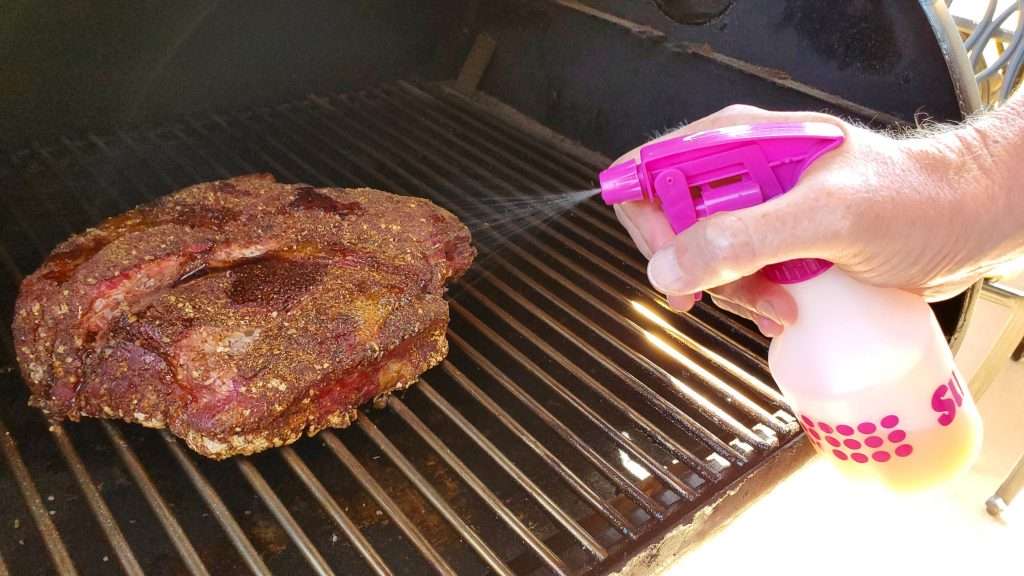
derrickriches.com
A BBQ spritz is typically a thin liquid placed in a food-safe spray bottle and lightly misted onto smoked meats. It can be anything from beef broth to leftover injection marinade. The trick to spritzing is not to make direct contact with the meat. Doing so could wash away that amazing bark. Instead, set your spray bottle to mist and mist at least 8-10 inches above the meat. Make sure to warm the spritz before using so that it does not reduce the temperature of the meat.
What is a BBQ mop?
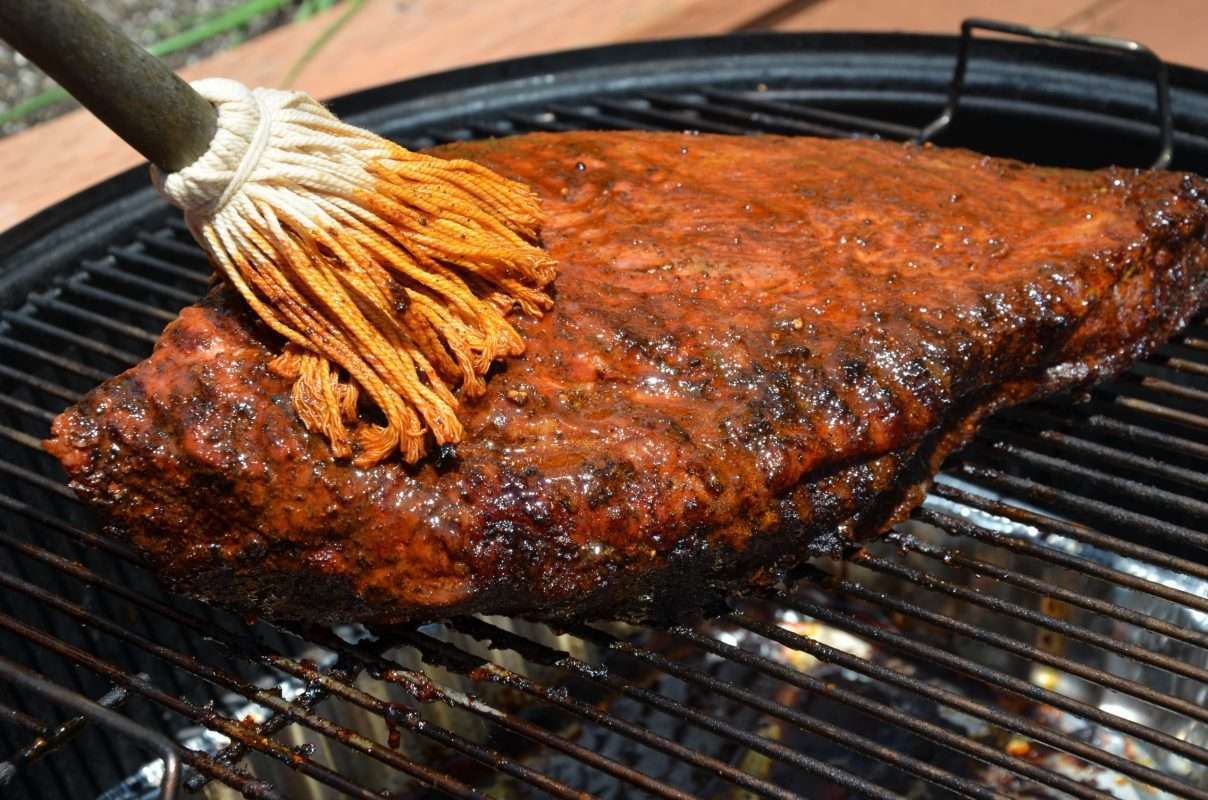
derrickriches.com
Mopping is the alternative to spritzing, where a thin liquid is applied with a BBQ mop brush. In Texas, a mop consists of beefy, Southwestern flavors like beef broth with Worcestershire sauce and earthy spices like chili powder and cumin. In areas like St. Louis, you will find that most mops are made with distilled or cider vinegar.
Mopping adds moisture to the surface, but most importantly, flavor. It is best done during the second half of the smoking time. Mopping several times will allow these flavors to build up into the crusty surface of the meat. Just like the spritz, a mop should be warmed before application.
Should you use a mop? Some Pitmasters are opposed to using mops as they feel it can erode the bark. However, if done right, the bark remains intact. Of course, the choice to sue a mop is entirely up to you. As always, it’s a good idea to experiment and find what works best for you.
Brisket Stall
The brisket has been cooking for many hours, and now you are starting to wonder when it will be ready. You’ll even notice that the internal temperature hasn’t budged in a while. This process usually shows up between 145-165 degrees F. That is an indication that the stall has arrived. No need to fear, but do keep in mind that it can take 1-3 hours to push past this point.
First and foremost, check your cooker for consistent temperature and fuel.
Wrapping: Butcher Paper vs. Foil
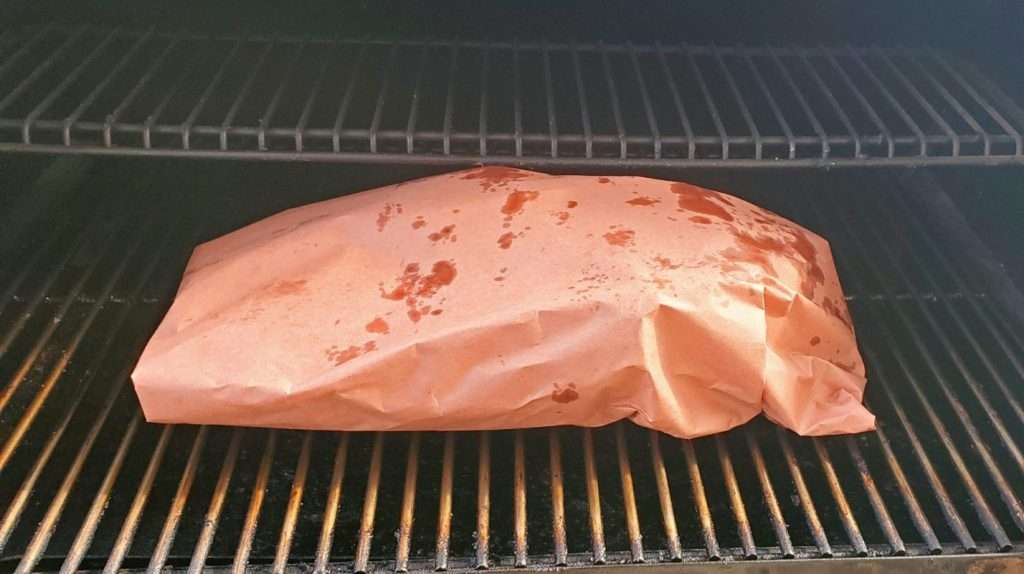
- Once the brisket reaches an internal temperature of 185 degrees F, it is time to wrap it and let it finish off. To do this, you need to wrap the brisket in pink butcher paper, keeping it warm and allowing the internal temperature to continue rising. Please note that pink butcher paper helps retain that delicious bark.

- If you’d like a more steamed finish, try the Texas crutch method of wrapping the brisket in aluminum foil. This method will soften the bark as well as the meat. It’s a great option for those who was a more fall apart brisket.
- What you are aiming for is a uniform doneness temperature throughout the brisket, around 203-205 degrees F.
Resting the Brisket
- Remove the wrapped brisket from the smoker and rest it. The resting time is super important for getting the tender, juicy, perfect brisket. Do not unwrap the brisket!
- Cooler: Competition cooks will place their wrapped brisket(s) in a clean cooler to hold in the heat. Wrap it securely with a heavy towel to hold the heat. Store it in the cooler for 2-3 hours. The insulative space will keep the wrapped brisket warm.
- Oven: Set your oven to 170 degrees F. Place the wrapped brisket onto a baking sheet and place it in the oven for 2-3 hours. The heat from the oven will not cook it further but will create a warm environment, much like the cooler, while it rests.
How to Carve a Brisket
Carving a brisket is more of an art than a science. In other words, it requires experience more than technique. If you go slow and watch what you are cutting, you shouldn’t have much trouble getting a large number of good slices that are just perfect for serving.
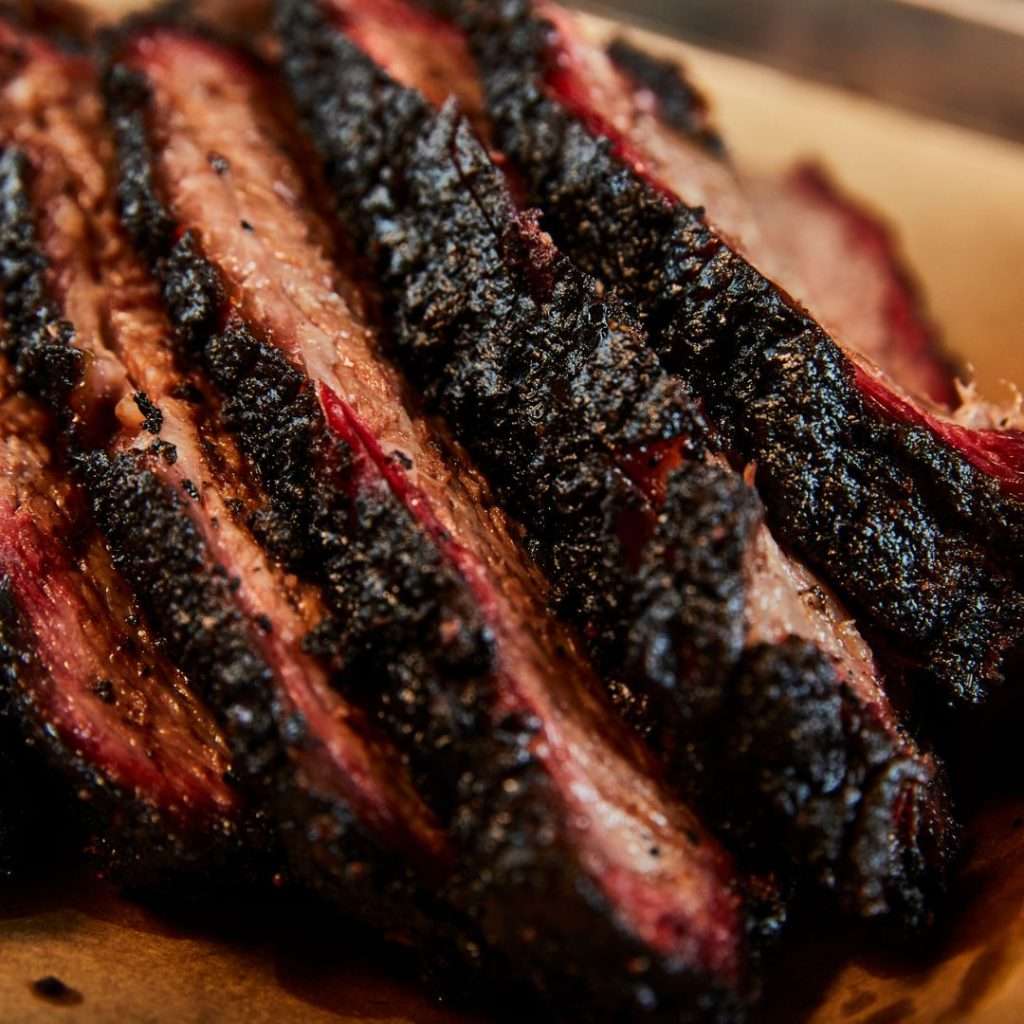
- Place the wrapped brisket in a large baking sheet. There will be juices, so you’ll need something underneath to collect it. Carefully unwrap the brisket, and transfer it to a cutting board. Pour the juices in a pan along with your brisket serving sauce. Trust us when we say that this brisket juices add a whole new level of flavor to BBQ sauce.
Against the grain
- For this task, it’s crucial to have a sharp, high-quality carving knife. This will ensure clean cuts and make the entire carving process much easier for you.
- Understanding the grain of the meat is a fundamentally important. Whether you cut against or with the grain can significantly impact the tenderness of your brisket. Given the time and effort you’ve invested in this project, it’s essential to finish strong.
- For brisket, you want to cut against the grain to avoid chewy meat. The goal is to cut through the muscle fibers straight down rather than in a back-and-forth motion. Essentially, you’ll be breaking through or collapsing the fibers, ensuring tender, juicy slices. Cutting with the grain will do the opposite, leaving you with hard-to-chew smoked brisket.
- Start by removing any extra fat remaining on the sides of the brisket.
- Next, start by carving the flat at an 90-degree angle into #2 pencil-thin slices.
- As you progress, you will run into the point which looks like two layers of muscle with a strip of fat in the center. If you look closely, you will see that the direction of the muscle grain has changed. Stop cutting, and instead, rotate the point section 90 degrees to begin carving against the grain again.
- Please note that you can save the point to make some delicious brisket burnt ends!
Serving Smoked Brisket
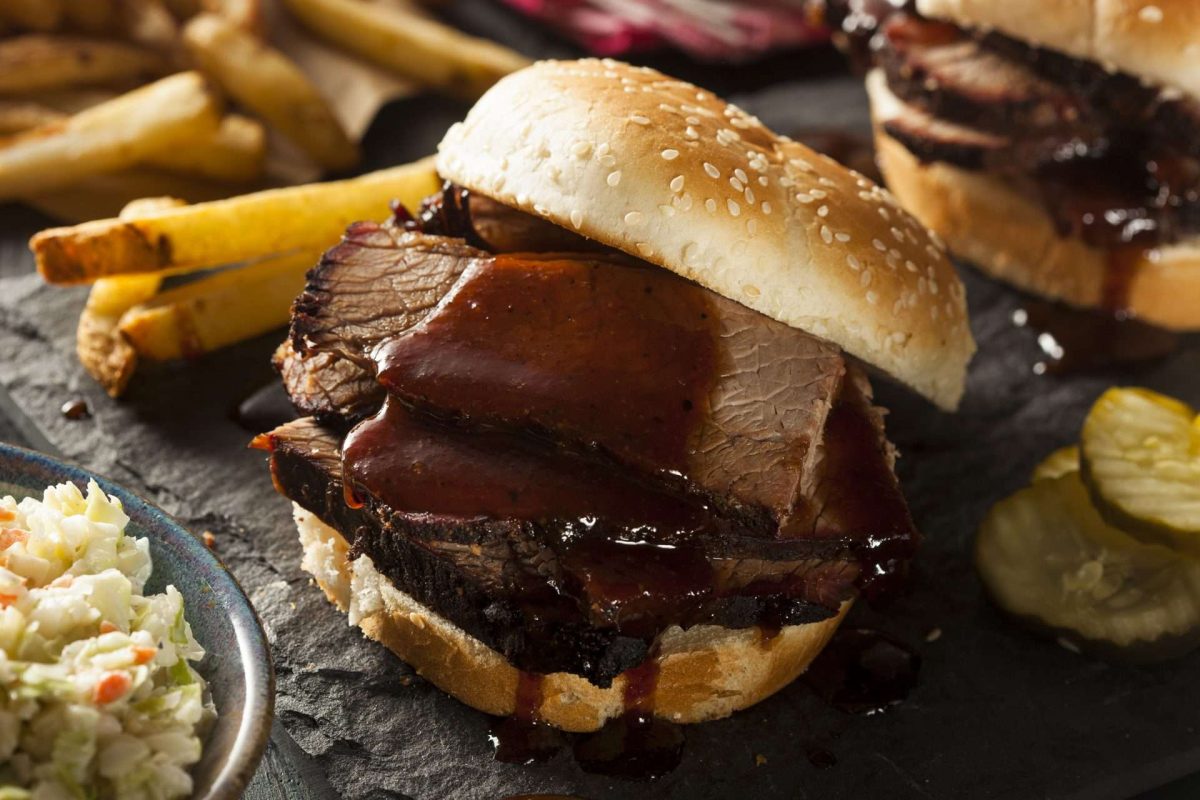
- Serve the brisket slices with BBQ side dish recipes like BBQ beans, slaw, potato salad, cornbread, pickles, and sauce. Or, use the slices in sandwiches.
- Smoked brisket is also a fantastic ingredient to use in many dishes.
- If you have leftovers, try turning them into a breakfast hash, tacos, or burritos. It makes a great chili, banh mi, or omelet.
Storing Leftovers
Store your sliced BBQ brisket in vacuum-sealed bags and freeze for up to 4 months. Thaw the bags in your refrigerator the night before you plan to use them. Reheat in the oven or a skillet on your stovetop.
The post How to Smoke a Brisket appeared first on BBQ & Grilling with Derrick Riches.
Did you miss our previous article...
https://manstuffnews.com/backyard-grilling/traeger-vs-recteq-rec-tec-mid-range-pellet-grill-showdown
 Backyard GrillingWeekend WarriorsAdvice from DadBeard GroomingTV Shows for Guys4x4 Off-Road CarsMens FashionSports NewsAncient Archeology World NewsPrivacy PolicyTerms And Conditions
Backyard GrillingWeekend WarriorsAdvice from DadBeard GroomingTV Shows for Guys4x4 Off-Road CarsMens FashionSports NewsAncient Archeology World NewsPrivacy PolicyTerms And Conditions
